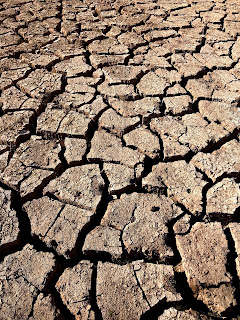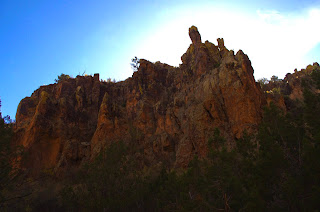My original plan three years ago was to do a loop hike to cover the deepest box canyon sections of East Red, Deep and Cold Spring Canyon on the east side of the San Mateo Mountains. Well the first obstacle to that, I found out quickly enough, was the lower section of Cold Spring almost to its confluence with East Red is in the midst of a quarter section of private property, which would necessitate climbing out of the canyon to avoid, and really defeat the whole purpose of the loop idea.
Next I thought about doing an out and back of East Red and Deep, but the first time I went, I parked a little too far back, and it was July, so all I ended up doing was East Red's box. A year later I parked closer and went through East Red again and then turned to explore a couple of miles up Deep Canyon. It was the summer again, but it was tolerable.
On Saturday ( 10/24/20 ), I went to Cold Spring Canyon which is also a tributary of East Red and is just to the east of Deep Canyon. I hiked a 2 and a half mile segment of the box section in between two private inholdings, and left the upstream segment, which is where the actual Cold Spring Trail ( FT 87 ) is, for another day.
I got to my trailhead, by turning off of FR 332 onto a nearly hidden two track, which used be FR 972, most of which is closed to vehicles now. I parked after less than a 1/4 mile beyond on a level bench where there was an old metal livestock drinking tank and a huge, riveted molasses container. It was about 9:45 when I began walking down the hill past the "Road Closed" gate down to a second level bench where the road then continues on all the way down to the bottom of the canyon.

Only I didn't see it. The continuation of the road that is. I looked all around, but didn't find it. Plan B. I scrambled down a rough ravine, weaving through the piñons and got to the bottom anyway. There was a remnant of the road when I got there, and I began to follow it, until I realized it was taking me the wrong way. I turned back and soon found a green 50 gallon drum with some rubber hose going in and out of it. The whole scene, once part of a water delivery system, was bone dry.

One thing that was immediately different about Cold Spring Canyon is that it is more like a lower elevation forest environment. There were tall ponderosas, alligator junipers and even a few deciduous oaks. East Red and Deep Canyon's more sparse and low growing vegetation made them feel more like the desert( of course the fact that I hiked both of those in the summer may have something to do with it also). Cold Spring Canyon has many springs both upstream and downstream, although none in the stretch that I hiked, so there may be an unseen underground flow, which could account for the greater plant diversity.



I walked on down a livestock/wildlife path, with the wildlife users being mainly bears it would seem, as their scat was frequently encountered on the trail.

 The cliffs in browns and tans rose up two hundred feet above me. Talus fields of boulders sloped down to the innermost channel, a sort of mini- canyon thirty feet deep that would appear intermittently.
The cliffs in browns and tans rose up two hundred feet above me. Talus fields of boulders sloped down to the innermost channel, a sort of mini- canyon thirty feet deep that would appear intermittently.

 Walnut trees, most in sad shape, a very few cottonwoods and sumac provided a small splash of fall color here and there. I ambled on mostly on the path through the dried grass and weeds, but occasionally bushwhacking through the shrubbery.
Walnut trees, most in sad shape, a very few cottonwoods and sumac provided a small splash of fall color here and there. I ambled on mostly on the path through the dried grass and weeds, but occasionally bushwhacking through the shrubbery.




Unlike East Red, but similar to Deep Canyon, I found no artifacts on ground, and the alcoves I investigated turned up nothing as well. I've heard there is at least one cave in Cold Spring that does have evidence of ancient inhabitants, but it is further downstream on the private property.

Still, this was a very pleasant autumn trek. The canyon, although less deep, and perhaps less impressive than Deep or East Red, had steady views of beautiful canyon sides for nearly the entire length of the hike I did, with the fall light and shadow show making magic even in the middle of the day.
I began to use the tracker on my On-X app so I would know when I reached the private property inholding boundary. It worked well. Just past where some huge boulders had calved from the cliffs, and precisely where my app showed me to be reaching the red line used to indicate private land, I came to a wire fence with green wooden posts that was to be my turnaround point.


On the way back, since I was making good time, I decided I would find the segment of the road I couldn't in the morning. I walked past where I had reached the bottom earlier, and soon found a very faint two track. Shortly, after a crossing or two of the dry streambed, I looked to left and there was the rocky road segment, clear as can be, cutting up the hillside.
I walked on just little farther to the boundary with the upper section of private property ( where there is no fence) and backtracked and climbed out on the recently found road. When I got to the top of that first bench, I still couldn't figure out how exactly I missed it in the morning.

Labels: camping, fall colors, hiking























































































